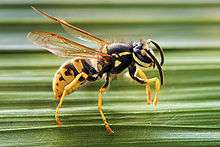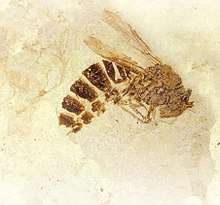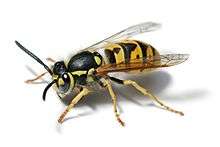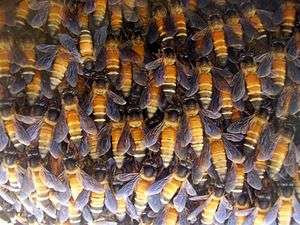Vespidae
The Vespidae are a large (nearly 5000 species), diverse, cosmopolitan family of wasps, including nearly all the known eusocial wasps (such as Polistes fuscatus, Vespa orientalis, and Vespula germanica) and many solitary wasps.[1] Each social wasp colony includes a queen and a number of female workers with varying degrees of sterility relative to the queen. In temperate social species, colonies usually only last one year, dying at the onset of winter. New queens and males (drones) are produced towards the end of the summer, and after mating, the queens hibernate over winter in cracks or other sheltered locations. The nests of most species are constructed out of mud, but polistines and vespines use plant fibers, chewed to form a sort of paper (also true of some stenogastrines). Many species are pollen vectors contributing to the pollination of several plants, being potential or even effective pollinators,[2] while others are notable predators of pest insect species.[3]
| Vespidae | |
|---|---|
 | |
| Vespula germanica | |
| Scientific classification | |
| Kingdom: | Animalia |
| Phylum: | Arthropoda |
| Class: | Insecta |
| Order: | Hymenoptera |
| Superfamily: | Vespoidea |
| Family: | Vespidae Latreille, 1802 |
| Subfamilies | |
|
Eumeninae: potter wasps | |

Although eight subfamilies are currently recognized, Raphiglossinae is likely also a valid subfamily. The subfamilies Polistinae and Vespinae are composed solely of eusocial species, while the Eumeninae, Euparagiinae, Gayellinae, Masarinae and Zethinae are all solitary with the exception of a few communal and several subsocial species. The Stenogastrinae are facultatively eusocial, considering nests may have one or several adult females; in cases where the nest is shared by multiple females (typically, a mother and her daughters) there is reproductive division of labor and cooperative brood care.[4]
In the Polistinae and Vespinae, rather than consuming prey directly, prey are premasticated and fed to the larvae, which in return, produce a clear liquid (with high amino acid content) for the adults to consume; the exact amino acid composition varies considerably among species, but it is considered to contribute substantially to adult nutrition.[5]
Fossils are known since Aptian of the Early Cretaceous, with several described species from Cretaceous amber.[6]
Gallery

 Median wasp nest
Median wasp nest- Polistes nest
 Vespa tropica from India
Vespa tropica from India Dolichovespula media (a European tree wasp) stripping wood from a fence for use in nest construction
Dolichovespula media (a European tree wasp) stripping wood from a fence for use in nest construction
External links
| Wikimedia Commons has media related to Vespidae. |
References
- Pickett, Kurt M.; Wenzel, John W. (2004). "Phylogenetic Analysis of the New World Polistes (Hymenoptera: Vespidae: Polistinae) Using Morphology and Molecules". Journal of the Kansas Entomological Society. 77 (4): 742–760. doi:10.2317/E-18.1.
- Sühs, R.B.; Somavilla, A.; Putzke, J.; Köhler, A. (2009). "Pollen vector wasps (Hymenoptera, Vespidae) of Schinus terebinthifolius Raddi (Anacardiaceae), Santa Cruz do Sul, RS, Brazil". Brazilian Journal of Biosciences. 7 (2): 138–143.
- "Wasp Nest Removal Guide". Saturday, July 4, 2020
- PK Piekarski, JM Carpenter, AR Lemmon, E Moriarty-Lemmon, BJ Sharanowski. (2018) Phylogenomic Evidence Overturns Current Conceptions of Social Evolution in Wasps (Vespidae). Molecular Biology and Evolution. 35:2097-2109. https://doi.org/10.1093/molbev/msy124
- Hunt, J.H.; Baker, I.; Baker, H.G. (1982). "Similarity of amino acids in nectar and larval saliva: the nutritional basis for trophallaxis in social wasps". Evolution. 36 (6): 1318–22. doi:10.1111/j.1558-5646.1982.tb05501.x. PMID 28563573.
- Perrard, Adrien; Grimaldi, David; Carpenter, James M. (April 2017). "Early lineages of Vespidae (Hymenoptera) in Cretaceous amber: Vespidae in Cretaceous amber" (PDF). Systematic Entomology. 42 (2): 379–386. doi:10.1111/syen.12222.
